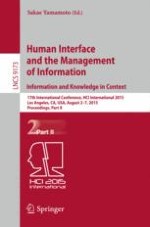2015 | OriginalPaper | Chapter
Representation Model of Collaboration Mechanism with Channel Theory
Authors : Patchanee Patitad, Hidetsugu Suto
Published in: Human Interface and the Management of Information. Information and Knowledge in Context
Publisher: Springer International Publishing
Activate our intelligent search to find suitable subject content or patents.
Select sections of text to find matching patents with Artificial Intelligence. powered by
Select sections of text to find additional relevant content using AI-assisted search. powered by
